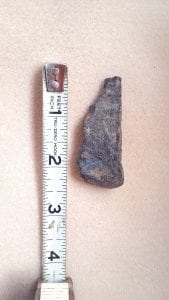Some county residents who must travel County Road 8—Devil Track Road— have complained that they are getting flat tires on their vehicles because of the road construction that will remain unfinished through the winter. One frustrated driver shared this photo of a rock that was removed from a flat tire.

A discussion at the September 27, 2011 county board meeting didn’t sit well with some of the people who live along County Road 8. Cook County Highway Engineer David Betts and Maintenance Supervisor Russell Klegstad discussed the condition of the road – it is in the middle of reconstruction and people are complaining about getting flat tires driving over it.
One local resident called the Cook County News-Herald and said he believes the condition of the road has caused at least 50 flat tires, many which he has helped change. He had four flat tires in one week, three of them that happened to “very good tires.” When they examine the tires, he said, they are finding rocks as sharp and flat as arrowheads stuck in the treads.
And people are not driving 60 miles per hour, as Commissioner Fritz Sobanja suggested, the caller said.
At the county board meeting, Betts and Klegstad said that with the current conditions, flat tires would be avoided by simply driving the construction speed limit of 35 miles per hour. According to the caller, blaming the problem on the drivers is “a little reckless” when people are pulling these types of rocks out of their tires.
The caller has tried contacting KGM Construction, the contractor in charge of the project, but he has not been able to get the right people to call him back to discuss his desire to make an insurance claim with KGM’s insurance company. He also expressed dissatisfaction with responses he had received from the Cook County Highway Department.
People are losing time as well as money dealing with flat tires, the caller said. And flat tires in the winter will involve the additional hazards of cold and darkness.
Klegstad contacted the News-Herald and shared his response to questions from a local resident regarding this issue:
“Speed is for sure the main issue with the road. That is not to say that a car driving the speed limit or less cannot get a flat tire. Here is my explanation:
“The road is built to black top specs. This calls for a flatter surface (2 percent) grade. Most of our gravel roads have a 3-to-4-percent crown. Asphalt requires Class 5 gravel as its base.
“To stabilize the surface and provide dust control, calcium chloride was sprayed on the surface. This does lots of good things, but the downfall is that under high-speed traffic it will pothole.
“Grading a road is preferred under wet conditions and never dry unless absolutely necessary. So what happens is this – Speeding traffic (45-60 mph) travels over the road when it is in good condition. This creates small potholes. It rains and the small potholes hold water. Traffic splashes in the holes, making the holes larger.
“There comes a point when the road becomes almost undriveable. The residents request grading, we call the contractor, and they come up to grade the project, but this time the road is somewhat dried and the grader will not cut the hard surface enough to remove the potholes.
“What happens then is the potholes will fill in, but with the loose rock that was originally brought to the surface by the speeding traffic. These holes can be four inches deep and now filled with rock – they become a trap for rocks – some that are sharp enough to catch in the tread of tires, and now a person comes along driving the speed limit but has no way of knowing where these traps are. They drive over them and then they also get a flat along with the speeders that caused most of the problems in the first place.
“Why don’t you get flat tires from our other gravel roads? They have slope (crown three to four percent) as required for gravel roads, they do not have as heavy of a base chloride treatment, therefore they do not pothole as bad, and if they do, the surface is not as hard (the chloride makes the road extremely hard).
“The road base has had longer periods of time to pack. We seldom do more than fourinch lifts on gravel roads. [On] No. 8 (Devil’s Track), the spec is 17 inches of Class 5 under the blacktop. On our gravel roads we use a Class 1 material which is slightly smaller on the rock sizes. This is not allowed under asphalt. We try to grade our gravel roads after a rain, and when we are forced to grade them dry, we try to do a follow-up as soon as it rains.
“This job is on a state aid road. If we don’t do things by the book and under the direction of the state aid engineer, Cook County stands to lose possibly a million dollars in federal aid and $1.5 million in state aid. They are the ones who control the game plan here, and while it is under construction it is under contract with KGM. We are not allowed to work on it with county equipment or time.
“Once the snow falls we will be able to manage the snow removal, but in the spring it will revert back to the contractor and I’m sure the potholes and poor conditions will be back for a time, but we hope for a great end result next year.
“I am truly sorry for the flat tires and the less-than-good driving conditions. I hope that I was able to answer some of your questions and also assure you that I am not out to get locals.”


Loading Comments